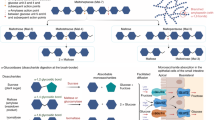Abstract
Pancreatic α-amylase plays an important role in dietary starch hydrolysis in the small intestine and participates in enhanced glucose concentration after meals. It seems to be a problem for diabetic patients, who suffer from longer postprandial hyperglycemia after meal consumption than healthy people. There are commercially available drugs that inhibit α-amylase and thus reduce the postprandial hyperglycemia effect. However, these drugs may cause severe side effects. Conversely, some naturally occurring flavonoids were suggested to have an α-amylase-inhibiting effect without any side effects. There had been no rapid, undemanding method in terms of sample and reagent preparation that would enable screening of many potential inhibitors. Therefore, we developed an online capillary electrophoresis method to monitor α-amylase activity in the presence of an inhibitor. Each reaction constituent was introduced separately, directly into a capillary where the reagents were mixed by diffusion, which resulted in a 5-min analysis including conditioning of the capillary. We applied the method to test the inhibitory effect of flavonoid standards and their mixture and we investigated the inhibitory effect of ethanolic extract from Betula pendula bark. The developed method presents a faster and less expensive alternative to previously described offline methods.

Online CE screening of α-amylase inhibitors






Similar content being viewed by others
References
Kalita D, Holm DG, LaBarbera DV, Petrash JM, Jayanty SS. Inhibition of α-glucosidase, α-amylase, and aldose reductase by potato polyphenolic compounds. PLoS One. 2018; https://doi.org/10.1371/journal.pone.0191025.
World Health Organization. Global burden of diabetes. In: Global Report on Diabetes 2016 http://apps.who.int/iris/bitstream/10665/204871/1/9789241565257_eng.pdf. Accessed 3 Sep 2017.
Erickson ML, Jenkins NT, McCully KK. Exercise after you eat: hitting the postprandial glucose target. Front Endocrinol. 2017; https://doi.org/10.3389/fendo.2017.00228.
Singh SK. Post-prandial hyperglycemia. Indian J Endocrinol Metab. 2012;16:245–7.
Hemalatha P, Bomzan DP, Rao BVS, Sreerama YN. Distribution of phenolic antioxidants in whole and milled fractions of quinoa and their inhibitory effects on alpha-amylase and alpha-glucosidase activities. Food Chem. 2016;199:330–8.
Liu X, Zhu L, Tan J, Zhou X, Xiao L, Yang X, et al. Glucosidase inhibitory acitivity and antioxidant activity of flavonoid compound and triterpenoid compound from Agrimonia Pilosa Ledeb. BMC Complement Altern Med. 2014; https://doi.org/10.1186/1472-6882-14-12.
Kuczmannová A, Balažová A, Račanská E, Kameníková M, Fialová S, Majerník J, et al. Agrimonia eupatoria L. and Cynara cardunculus L. water infusions: comparison of anti-diabetic activities. Molecules. 2016;21:564–75.
Harmon BJ, Patterson DH, Regnier FE. Mathematical treatment of electrophoretically mediated microanalysis. Anal Chem. 1993;65:2655–62.
Krylova SM, Okhonin V, Evenhuis CJ, Krylov SN. The Inject-Mix-React-Separate-and-Quantitate (IMReSQ) approach to studying reactions in capillaries. Trends Anal Chem. 2009;28:987–1010.
Nováková S, Van Dyck S, Van Schepdael A, Hoogmartens J, Glatz Z. Electrophoretically mediated microanalysis. J Chromatogr A. 2004;65:173–84.
Nehme R, Nehme H, Roux G, Destandau E, Claude B, Morin P. Capillary electrophoresis as a novel technique for screening natural flavonoids as kinase inhibitors. J Chromatogr A. 2013;1318:257–64.
Krylova SM, Okhonin V, Krylov SN. Transverse diffusion of laminar flow profiles—a generic method for mixing reactants in capillary microreactor. J Sep Sci. 2009;32:742–56.
Řemínek R, Zeisbergerová M, Langmajerová M, Glatz Z. New capillary electrophoretic method for on-line screenings of drug metabolism mediated by cytochrome P450 enzymes. Electrophoresis. 2013;34:2705–11.
Guo LP, Jiang TF, Lv ZH, Wang YH. Screening alpha-glucosidase inhibitors from traditional Chinese drugs by capillary electrophoresis with electrophoretically mediated microanalysis. J Pharm Biomed Anal. 2010;53:1250–3.
Ferreira JPA, Quilhó T, Pereira H. Characterization of Betula pendula outer bark regarding cork and phloem components at chemical and structural levels in view of biorefinery integration. J Wood Chem Technol. 2017;37:10–25.
Herrero-Martinez JM, Schoenmakers PJ, Kok WT. Determination of the amylose-amylopectin ratio of starches by iodine-affinity capillary electrophoresis. J Chromatogr A. 2004;1053:227–34.
Aghajari N, Feller G, Gerday C, Haser R. Structural basis of alpha-amylase activation by chloride. Protein Sci. 2002;11:1435–41.
Miranda I, Gominho J, Mirra I, Pereira H. Fractioning and chemical characterization of barks of Betula pendula and Eucalyptus globulus. Ind Crop Prod. 2013;41:299–305.
Acknowledgements
We thank to Assoc. Prof. Václav Richtr (Department of Chemistry, University of West Bohemia) for the Betula pendula extract.
Funding
This study was financially supported by the Charles University (SVV grant no. 260440) and Charles University Research Centre program No. UNCE/SCI/014. This study does not contain any studies with human participants or animals performed by any of the authors.
Author information
Authors and Affiliations
Corresponding author
Ethics declarations
Conflict of interest
The authors declare that they have no conflict of interest.
Rights and permissions
About this article
Cite this article
Hodek, O., Křížek, T., Coufal, P. et al. Online screening of α-amylase inhibitors by capillary electrophoresis. Anal Bioanal Chem 410, 4213–4218 (2018). https://doi.org/10.1007/s00216-018-1073-z
Received:
Revised:
Accepted:
Published:
Issue Date:
DOI: https://doi.org/10.1007/s00216-018-1073-z




